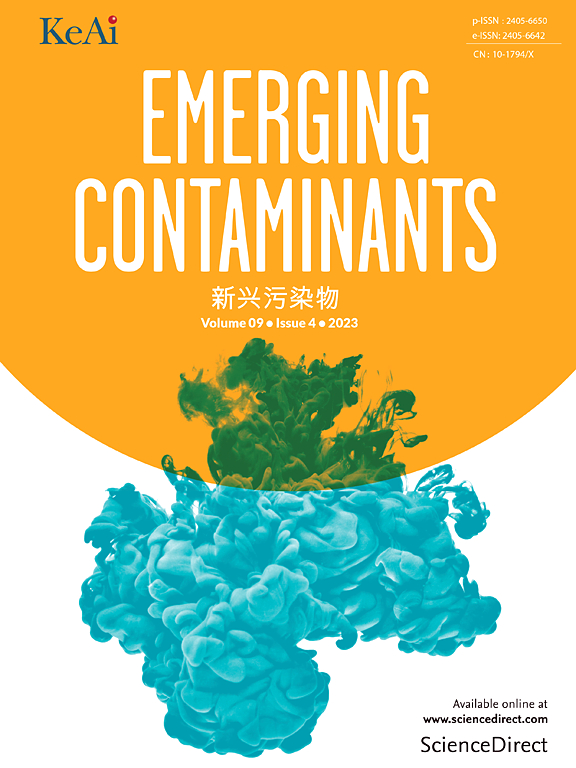Occurrence of micropollutants and enterobacteria in Ticino Valley: an insight of water contamination in an agricultural area with highly anthropogenic impact
IF 6.9
2区 环境科学与生态学
Q1 ENVIRONMENTAL SCIENCES
引用次数: 0
Abstract
This study investigates the groundwater quality of an aquifer located in medium-populated area of the Ticino Valley with strong agricultural vocation. Two monitoring campaigns were carried out according to the phases of rice cultivation (pre- and post-flooding) on the subsurface and surface irrigation network, Ticino River and wastewater effluents, highlighting a diffuse contamination. The isotopic analyses evidenced mixing phenomena, with both contributions from local rainfall and irrigation network. Combining chemical and microbiological approaches, the anthropogenic impact was evaluated by analysing a selection of traditional and emerging pollutants, such as pesticides, antibiotics and hormones, and assessing the extent of enterobacterial contamination and potential antibiotic resistance genes. Most of the investigated contaminants were found in concentrations from 0.1 ng/L to 632 ng/L, with the exception of Glyphosate and AMPA up to 5 and 20 μg/L, respectively. Even at these low concentrations, contamination of water resources is a serious issue because long-term exposure to such pollutants may cause detrimental effects. The most frequently detected pesticide was the fungicide Tricyclazole, while glucocorticoid Dexamethasone was the most frequent steroid hormone. Noteworthy is the ubiquity of Trimethoprim and a recurrent presence of fluoroquinolones. The occurrence of antibiotics at most sites, although at very low levels, is of environmental and public health concern, as they exert a selective pressure on bacterial populations, allowing the development of antibiotic resistant microbes, as highlighted by microbiological investigations. Indeed, a high microbial load was found in both campaigns, in particular in those sampling sites close to wastewater treatment plants, with the β-lactams and quinolones classes of antibiotics as the most affected by the phenomenon of resistance.

提契诺山谷微污染物和肠杆菌的发生:对高度人为影响农业区水污染的洞察
本研究对提契诺河谷人口中等、农业产业较强的含水层的地下水水质进行了研究。根据水稻种植阶段(洪水前和洪水后),对地下和地表灌溉网络、提契诺河和废水排放进行了两次监测运动,突出了弥漫性污染。同位素分析证明了混合现象,当地降雨和灌溉网络都有贡献。结合化学和微生物学方法,通过分析农药、抗生素和激素等传统和新兴污染物的选择,并评估肠杆菌污染的程度和潜在的抗生素抗性基因,评估了人为影响。除草甘膦和AMPA分别高达5和20 μg/L外,大多数污染物的浓度在0.1 ~ 632 ng/L之间。即使在这种低浓度下,水资源污染也是一个严重问题,因为长期接触这种污染物可能造成有害影响。检出频率最高的农药是杀菌剂三环唑,而检出频率最高的类固醇激素是糖皮质激素地塞米松。值得注意的是甲氧苄啶的普遍存在和氟喹诺酮类药物的反复出现。正如微生物学调查所强调的那样,抗生素在大多数地点的出现,虽然水平很低,但引起了环境和公共卫生方面的关注,因为它们对细菌种群施加了选择性压力,使抗生素耐药微生物得以发展。事实上,在这两个运动中都发现了较高的微生物负荷,特别是在靠近废水处理厂的采样点,β-内酰胺类和喹诺酮类抗生素受耐药性现象影响最大。
本文章由计算机程序翻译,如有差异,请以英文原文为准。
求助全文
约1分钟内获得全文
求助全文
来源期刊

Emerging Contaminants
Medicine-Public Health, Environmental and Occupational Health
CiteScore
10.00
自引率
6.70%
发文量
35
审稿时长
44 days
期刊介绍:
Emerging Contaminants is an outlet for world-leading research addressing problems associated with environmental contamination caused by emerging contaminants and their solutions. Emerging contaminants are defined as chemicals that are not currently (or have been only recently) regulated and about which there exist concerns regarding their impact on human or ecological health. Examples of emerging contaminants include disinfection by-products, pharmaceutical and personal care products, persistent organic chemicals, and mercury etc. as well as their degradation products. We encourage papers addressing science that facilitates greater understanding of the nature, extent, and impacts of the presence of emerging contaminants in the environment; technology that exploits original principles to reduce and control their environmental presence; as well as the development, implementation and efficacy of national and international policies to protect human health and the environment from emerging contaminants.
 求助内容:
求助内容: 应助结果提醒方式:
应助结果提醒方式:


